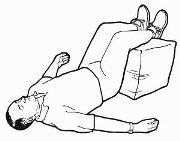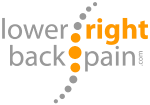The Egoscue Method is a do it yourself (non-medical) pain relief, and posture therapy developed by Pete Egoscue. Pete Egoscue has been helping people relieve themselves of chronic pain since the early 70s and has been labeled as the Father of Postural Therapy. He has authored six books. The Egoscue exercises involves a series of stretches that designed for a particular dysfunctional postural alignment pattern. The average person’s posture has dysfunction and could use realignment. The Egoscue method is designed to stop chronic pain and is deeply rooted in the belief that your body will never let you down. Their mantra is “Your design isn't flawed, your posture is.”
The Egoscue method is a series of gentle corrective exercises they call “e-cises”. Their somewhat custom approach aims to bring your posture back into balance and return your body to proper function. Pete Egoscue holds faith in the evolution of humankind and it operational experience in dealing with pain. The Egoscue Method is based on the body's functional design – or posture. The main objective is to teach the client how to listen to their own body and keep it properly tuned.
The Egoscue Exercises or “E-Cises”
Note: The Egoscue Method recommends that all the E-cises be performed in order. This is due to the fact that some of the exercises require prerequisite stretching or alignment.
Static Back – uses gravity to relax the back and torso muscles. Lying on your back, legs supported on a box (or chair) with hands at 45 degree angles.

Static Back with deep breathing (similar to ZIP and Tuck)
Abdominal Contractions while in static back position – Breathe deep and contract your abs for three seconds after you exhale.
Abductor Presses – Basically Static back position using a belt or tie to hold your knees together (while feet remain a shoulder width. You will tense against the resistance by trying to pull your knees apart. This exercise strengthens the hip muscles and other thigh muscles (which help spread the legs apart). Three sets of ten is recommended
Overhead Extensions – Stand with feet pointing straight ahead, shoulder width apart. Head and shoulder should be pulled back, hips rolled forward (into extension). Push your hands to the sky palms up with your fingers interlaced. Arms should be fully extended directly above your head. Tilt your head back (looking at the back of your hands). Hold position for 30 seconds.
Elbow Curls (on wall) – The wall helps keep the body in line. Stand with back and head against the wall (be sure to keep feet hip-width apart and pointing straight ahead – as with most Egoscue exercises). Make fists and put your knuckles on your temples (thumbs pointing down and elbows pointing out as wide as possible, touching the wall) – this is your starting position. From here you want to slowly bring your elbows together and touch them in front of your face, pause and return to full extension. Keep your head back and be cognizant of your hands and keep them slightly in contact with your head.
Static Wall – Lye on your back and place your legs vertically up the wall (creating a 90 degree angle). Feet Hip width apart and legs and butt as close to the wall as possible (as long as hips remain on the floor). As an added variation, alternate bringing one leg off the wall 3 inches or so. Be sure to keep your foot flexed and thigh tight. 15 reps are recommended
Static Extension –Down on all fours with hands six inches in from of your shoulders. Knees and hands in alignment (this is similar to Cow (Yoga) pose with knees further back). Relax your low back and let your shoulder blades come together. Lean forward so your shoulders a now directly above your hands. It is recommended to hold this position for 1-2 minutes. Relax and allow your head to fall forward. You should be able to feel your spine stretch and fall into alignment.
Upper Spinal Twist – lye on your back with knees bent at 90 degree angle. Close side arm will hold your knees in place while your other are is extended out away from your knees stretching your torso and chest. Your palm and head should be facing up to the sky. Hold for three minutes (or longer). The goal is to relax and have your shoulders evenly fall against the floor. Breathe and allow your boy to melt into this position. Knees should remain symmetrical (side by side).
Pelvic tilts – Lie on your back with knees bent and feet flat on the floor. Your heels should be about 12” to 16” from your butt. Flatten your lower back by rolling your hips forward then roll your hips back to make an arch under your low back. Do these “rolls” continuously for 10 repetitions. Keep your feet and legs still throughout the exercise. Inhale on the way up and exhale as you go down. This exercise is designed to strengthen and release the torso muscles.
Supine Groin Progressive – This exercise is designed to unlock tight hip flexors and is said to be very effective. Lie on your back with one leg bent and 90 degrees while the other leg is extended out resting on a 15” Object (box or step). The foot of the extended leg should be braced to keep it from rolling outward. This position should be held relaxed for at least 10 minutes. The extended leg should then be lowered down to 7” or the ground and held in place for another 10 minutes. Switch legs and repeat. You are looking for your leg muscles to release and fall into proper alignment. To test if your leg has released you can flex you thigh muscle. If you feel a solid contraction (without twitching in the middle of the thigh, your leg has released.
Air Bench – Push your back against a wall and slowly scoot your back down the wall as you step your feet further out from the wall. Continue until your thighs are at 90 degrees from the floor (as if sitting in a chair). Your knees should be at hip width apart in line with your ankles (not over your toes).This will be very taxing on your thigh muscles. The goal is ultimately to hold this position for three minutes but this will take time. Start slow, keep proper form and slowly increase your hold times. If you feel pain in your knees move your hips higher up the wall. Shake your legs out when finished.
